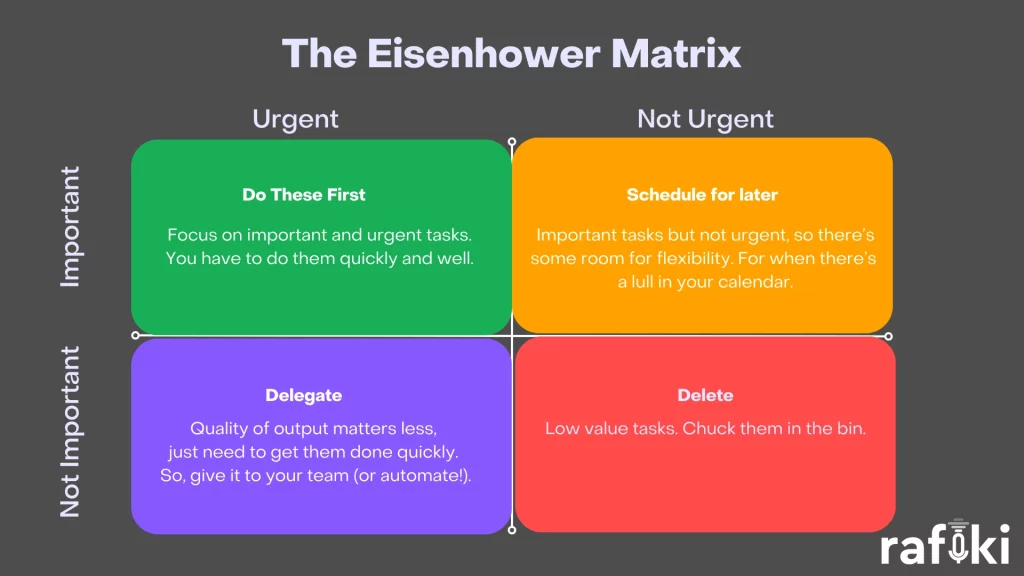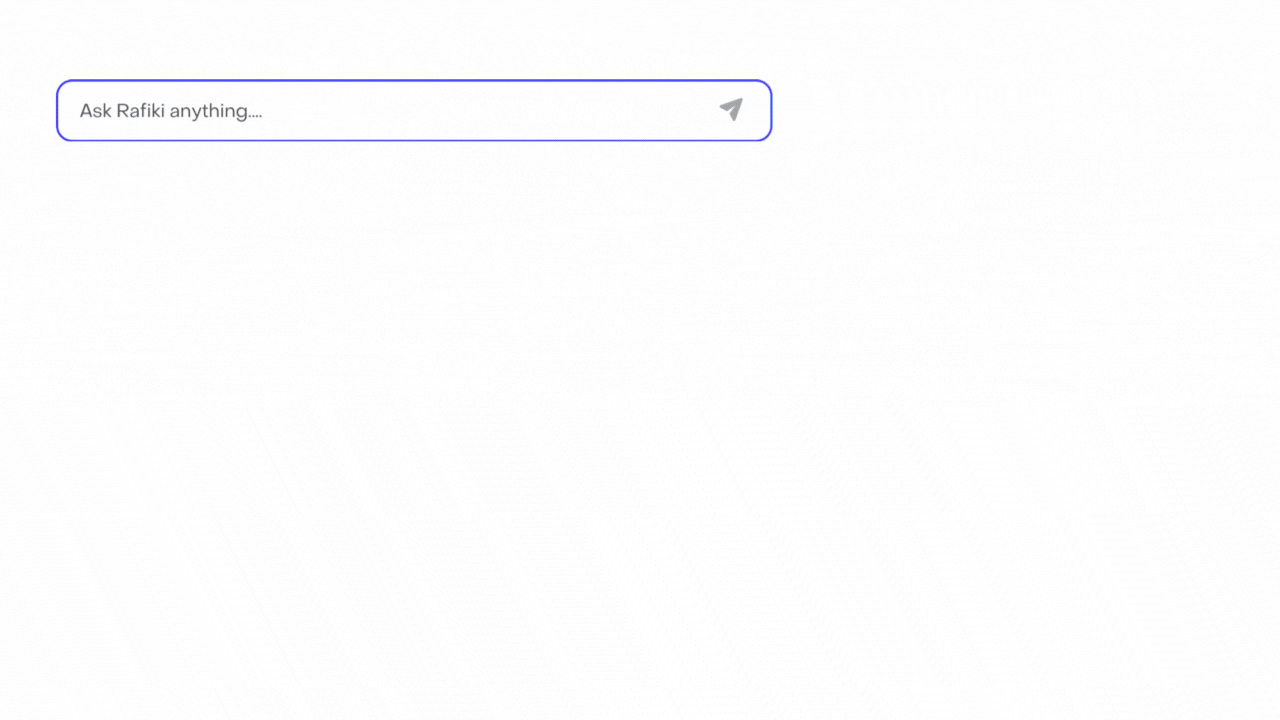Why Rafiki
Pricing


Pricing
Solutions

RevOps Leaders
Synchronize revenue generating functions

SDR Leaders
Get your team aligned and Coach your Reps 3x faster at scale

Sales Leaders
Unlock pipeline truth, drive confident forecasts

Ever feel like there just aren't enough hours in the day? You're not alone. Sales professionals juggle a million tasks: prospecting calls, demos, follow-ups, meetings, you name it. But without a well-oiled calendar, it's easy to get swamped. Imagine forgetting a key client meeting or spending hours hunting for that prospect's email address because of bad calendar management.
Yikes!
Let's face it, a disorganized calendar is a recipe for missed opportunities and major frustration. But hey, there's good news! By taking control of your schedule, you can become a master of your time and keep your calendar running without bottlenecks or delays.
Even the most organized professionals can fall victim to calendar pitfalls and end up with calendars that look like this:

Overlapping events, no routine, no organization.. it's just bad calendar management. So, here are some common mistakes to watch out for:
Ever feel like you're constantly chasing down leads without a clear direction? Here's how to stop the madness! Tip #1 is all about aligning your calendar with the specific stages of your sales cycle. Think of your sales process as a journey, with defined steps like prospecting, qualification, demos, and closing.
By dedicating specific blocks of time in your calendar for each stage, you ensure you're actively moving deals forward and not letting opportunities stagnate. Imagine reserving mornings for focused prospecting calls, afternoons for demos and presentations, and leaving dedicated time for proposals and contract negotiations. This strategic approach in calendar management keeps you laser-focused on the tasks that drive revenue and prevents important steps from falling through the cracks.
Scheduling that perfect meeting with a busy prospect can feel like navigating a minefield. Tip #2 equips you to become a scheduling ninja! The key lies in respecting your prospect's time zone and preferences. Utilize tools like scheduling links that allow them to pick a convenient time slot within your availability. Gone are the days of endless email exchanges!
But here's the secret weapon: leveraging technology. Explore scheduling assistants like Calendly, Calendar, SavvyCal that integrate with your calendar. These tools can streamline the process by automating back-and-forth emails and finding a mutually agreeable time for both you and your prospect. Imagine the time saved!
Not all activities deserve equal space on your calendar. Tip #3 focuses on ruthless prioritization, but with a twist. Identify the high-value tasks that directly contribute to revenue generation, like qualifying leads, crafting proposals, and delivering demos. These activities deserve prime real estate in your schedule.
However, remember, sales is a dynamic field. Leave buffer time throughout your day for unexpected opportunities or last-minute client requests. A rigid schedule can hinder your ability to capitalize on these situations. Think of it as finding the perfect balance: prioritize ruthlessly to ensure progress on key deals, but also maintain some flexibility to adapt to the ever-changing sales landscape. This ensures you're maximizing your time for revenue-driving activities while remaining responsive to urgent needs.
Here’s a reminder on how to prioritize activities using the Eisenhower Matrix:

Multitasking might seem like a superpower, but it can actually be your productivity kryptonite. Tip #4 introduces the concept of "time blocking," a technique to maximize focus. Here's the idea: group similar activities together in dedicated time slots. For example, block a morning slot for all your prospecting calls.
This allows you to enter a state of "flow," where you can concentrate on the task at hand and knock out calls efficiently. Imagine the difference between constantly switching gears throughout the day and dedicating uninterrupted time for focused activity.
By batching similar activities, you minimize context switching, that mental drain caused by jumping between tasks. This not only improves your focus but also helps you avoid that feeling of being overwhelmed. So ditch the multitasking myth and embrace the power of batching! You'll be amazed at how much more you can accomplish in a shorter amount of time with this tip for proper calendar management.
Technology is your ultimate sales sidekick, and Tip #5 is all about using it to your advantage. Say goodbye to the days of endless back-and-forth emails for scheduling meetings. Many CRMs seamlessly integrate with calendar apps, allowing you to schedule meetings directly from a prospect's profile within your CRM. This eliminates manual data entry and keeps everything centralized for smooth organization.
Explore scheduling assistants that can be your secret weapon. These integrate with your calendar and automate the time-consuming dance of finding a mutually agreeable meeting time with prospects. Imagine sending a scheduling link that allows them to pick a slot that works best for them, eliminating the need for endless email exchanges.
Internal meetings are essential for collaboration, but they can also be notorious time-wasters that worsen your calendar management. Tip #6 equips you to conduct efficient and productive internal meetings. Here's the key: respect everyone's valuable time. Always come prepared with a clear agenda and circulate it beforehand. This ensures everyone arrives focused and ready to contribute.
Start and end meetings on time, avoiding unproductive tangents and rabbit holes. Focus on clear communication and actionable discussions. Instead of lengthy presentations, consider using collaborative tools to share ideas and updates beforehand.
Rafiki's Smart Call Summary can also be a huge asset here. By automatically summarizing calls with advanced AI, it eliminates the need for lengthy meeting recaps and ensures everyone's on the same page. By following these steps, you transform internal meetings from time sucks into focused sessions that drive progress and keep your team moving forward.
Not all meetings are created equal. High-stake encounters with key decision-makers require extra preparation. Tip #7 equips you to confidently navigate these crucial interactions. Firstly, ensure you have a crystal-clear understanding of the meeting's objectives and desired outcomes. What do you want to achieve? What specific actions should be taken after the meeting? Having a clear roadmap keeps the discussion focused and avoids aimless meandering in calendar management.
Secondly, prepare a compelling agenda in advance and circulate it to attendees. This sets expectations, allows them to come prepared, and ensures everyone's on the same page.
Finally, after the meeting, send a quick follow-up email summarizing key takeaways and next steps. This ensures everyone is aligned on the action plan and keeps the momentum going. Rafiki’s Smart Follow Up can automatically craft a relevant and personalized followup based on the meeting, so that all you have to do is click “Send”.
You wouldn't expect your car to run on fumes, so why treat yourself the same way? Tip #8 emphasizes the importance of scheduling self-care and breaks into your calendar. Think of it as an investment in your sales success.
Just like your phone needs charging, you need dedicated time to recharge your mental batteries. Block out time for activities that energize you, whether it's a midday walk, a healthy lunch break, or a quick meditation session. These moments of rejuvenation will boost your focus, creativity, and overall well-being.
Remember, neglecting self-care can lead to burnout, hindering your ability to perform at your peak. By strategically scheduling breaks and prioritizing your well-being, you'll approach each interaction with renewed energy and enthusiasm, ultimately leading to more sales wins.
Your sales calendar is a living document, not a dusty relic. Tip #9 highlights the importance of regular review and adaptation. Dedicate some time each week (or even daily) to analyze your calendar usage. Are there recurring tasks that can be streamlined? Are there time blocks that are consistently underutilized?
Think of it as fine-tuning a race car - small tweaks can lead to significant performance gains. Don't be afraid to experiment and adapt your calendar based on your progress and evolving needs. Through consistent review and refinement, you can transform your calendar from a simple scheduling tool into a powerful weapon for sales success.
Ask Rafiki Anything can be a powerful tool here. Imagine asking, "What are my most productive times for calls?" and getting data-driven insights to optimize your schedule. By analyzing this data, you can identify areas for improvement and make adjustments to maximize your efficiency.

Data is king in the sales world, and Tip #10 is all about harnessing its power to optimize your calendar. Many CRM and sales communication platforms offer robust analytics features. Dive into these reports to gain a deeper understanding of how you're utilizing your time.
For instance, analyze the effectiveness of your current call schedule. See which days and times yield the highest engagement and conversion rates for prospecting calls. This data can help you refine your calendar to prioritize the most productive time slots for lead generation.
Rafiki's Smart Call Scoring can be another valuable asset here. It goes beyond simply measuring call duration. By analyzing your communication style and content, it identifies areas for improvement. Leverage these insights to tailor your approach for different call types, maximizing your chances of securing those all-important meetings and closing deals.
Mastering your sales calendar isn't about fancy tricks or superhuman willpower. It's about implementing these practical tips and taking control of your time. Imagine the feeling of accomplishment: a streamlined schedule, focused activities, and less time spent feeling overwhelmed.
Save 2 Hours of Your Reps' Time Everyday
By following these steps, you'll transform your calendar from a to-do list into a strategic roadmap for sales success. So, are you ready to ditch the chaos and watch your sales soar? Take action today and start building your dream sales calendar!